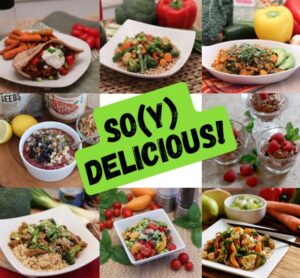 Did you read last week’s coaching tip on soy?
Did you read last week’s coaching tip on soy?
If so, you read about how whole soybean foods can provide nutritional benefits and be part of a healthy REAL food lifestyle.
Since you may not necessarily be familiar with some of these soy products (we certainly weren’t when we started our REAL food journey!), we want to provide some helpful information on the most prevalent soy products and how to enjoy them!
Edamame
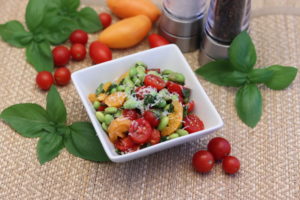 These are the little green pods you see at many sushi and Japanese restaurants. They are made from soybeans that are harvested while they’re still a little immature. They have a mild, slightly sweet flavor and a firm texture. When they have been removed from their pods, you will see them called mukimame. You can typically find edamame both in the pods or shelled in the frozen section of most grocery stores.
These are the little green pods you see at many sushi and Japanese restaurants. They are made from soybeans that are harvested while they’re still a little immature. They have a mild, slightly sweet flavor and a firm texture. When they have been removed from their pods, you will see them called mukimame. You can typically find edamame both in the pods or shelled in the frozen section of most grocery stores.
A half cup of frozen shelled edamame has 8 grams of fiber and 8 grams of protein. You can also find dry roasted edamame in many stores, which has a crunchy texture and makes a great salad topping or on-the go snack.
Enjoy edamame in dishes like the Edamame Tomato Basil Salad, Edamame Chickpea Feta Salad, Roasted Garlic Parmesan Edamame, Spring Green Couscous, Summer Veggie Succotash, Orange Farro Salad with Spring Veggies, and the Green Lemon Zucchini Risotto, just to name a few.
Tempeh
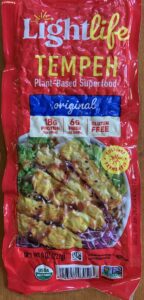 Tempeh is a fermented soybean product. It is made by cooking and fermenting whole soybeans, which creates a slightly chewy texture and a nutty flavor.
Tempeh is a fermented soybean product. It is made by cooking and fermenting whole soybeans, which creates a slightly chewy texture and a nutty flavor.
A 3 oz serving has 6 grams of fiber and 18 grams of protein. Some tempeh is made from soybeans alone, while others combine soybeans with other grains like brown rice or barley.
When you open the package of tempeh, it will be shaped in a block. Don’t panic — it crumbles easily and then resembles ground turkey and is versatile to enjoy in a wide range of dishes. We have even used it as a bacon replacement like in the Egg Topped Cauliflower Couscous. (We love the texture of tempeh, it is definitely one of our favorite soy products!)
 Other delicious ways to enjoy it include the Tempeh Sloppy Joes, Egg Roll in a Bowl, Tempeh Tacos, Szechuan Tempeh Stir Fry, and the Smoky Swiss Chard Quesadillas.
Other delicious ways to enjoy it include the Tempeh Sloppy Joes, Egg Roll in a Bowl, Tempeh Tacos, Szechuan Tempeh Stir Fry, and the Smoky Swiss Chard Quesadillas.
Tofu
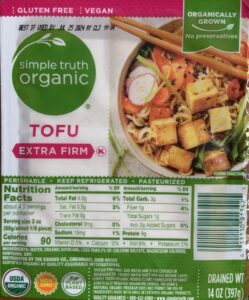 Tofu is probably what comes to mind first when you think of soybean products and plant-based protein. It is made by coagulating the protein and oil in soymilk, and then pressing the liquid out to get a solid block of tofu. It has a very neutral taste and will take on the flavors of other ingredients in both sweet and savory dishes.
Tofu is probably what comes to mind first when you think of soybean products and plant-based protein. It is made by coagulating the protein and oil in soymilk, and then pressing the liquid out to get a solid block of tofu. It has a very neutral taste and will take on the flavors of other ingredients in both sweet and savory dishes.
You will see different varieties, which primarily relate to how much liquid remains in the finished product. It is typically found in the refrigerated section of most grocery stores.
Silken tofu has a higher water content and softer texture and is a great option for dishes like the Very Berry Smoothie Bowl, Mini Strawberry Cream Bites, and the Dark Chocolate Mousse.
 Firm and extra firm tofu have had more liquid removed and maintain their shape better when cooked. You will sometimes also find a “super firm” variety that has had even more water removed and is the most dense and solid.
Firm and extra firm tofu have had more liquid removed and maintain their shape better when cooked. You will sometimes also find a “super firm” variety that has had even more water removed and is the most dense and solid.
Tofu doesn’t have as much fiber as edamame or tempeh, but it is a great source of protein (9 grams for a 3 oz serving).
 What about pressing tofu?
What about pressing tofu?
When using firmer varieties of tofu, you may need to slightly press the tofu to squeeze more of the water out. Simply hold it over a bowl or the sink and squeeze it a couple times to remove most of the water.
If desired, you can also wrap it in a kitchen towel (or paper towels), and place it on a plate or cutting board. Then, place a cast iron skillet or other heavy skillet or pot on top (a baking sheet between the tofu and the skillet or pot can help add some stability), and let it sit for about 30 minutes.
Another trick is to freeze it, and then transfer it to the refrigerator to thaw for a couple of days. Then, when you open the package, quite a bit of water will pour out. A gentle squeeze will remove even more water, eliminating the need to press the tofu.
Keep in mind, this “freeze and thaw” method will give your tofu a slightly firmer and chewier texture. Don’t worry about getting it completely dry – just squeeze out what you can and enjoy it in your recipe. One of our favorites is the Southwest Tofu Scramble, and we think you will love the Bacony Tofu Bites!
Soy sauce
Surely, everyone knows about soy sauce! It is typically made from fermented soybeans, wheat, water, and salt and adds a unique umami flavor to a variety of dishes. You will also see Tamari, which is made without wheat and is gluten free. Soy sauce is particularly high in sodium. Even “less sodium” varieties can have 600mg or more of sodium in 1 Tbsp. Because the flavor is so intense, a little can go a long way. It is great in marinades, stir-fries and sauces.
If you’re looking for inspiration, try the Asian Beef with Peppers, Hoisin Burgers, Thai Vegetable Noodle Stir Fry, Pineapple Pork Fried Rice, Honey Lime Sriracha Cauliflower, Asian Style Sloppy Joes, and the Skillet Jambalaya, plus many more!
Miso
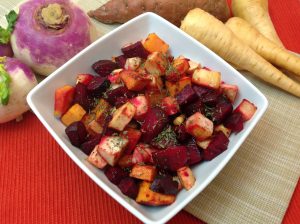 Miso is a flavorful, fermented paste made from soybeans and rice, barley, or other grains. Some varieties are gluten free, while others are not. There are several different types of miso that vary based on their ingredients. Common varieties include white, yellow and red.
Miso is a flavorful, fermented paste made from soybeans and rice, barley, or other grains. Some varieties are gluten free, while others are not. There are several different types of miso that vary based on their ingredients. Common varieties include white, yellow and red.
White miso is typically the lightest variety while you can think of red as the stout beer of the miso world. Like soy sauce, it provides a punch of umami flavor, but is also high in sodium. Again, a little can go a long way.
Give miso a try in dishes like the Miso Maple Roasted Vegetables, Veggie Noodle Bowl, Glazed Turnip and Kohlrabi Salad, Honey Sesame Salmon with Asian Rice Salad, Fall Harvest Kale Salad, and the Roasted Butternut Squash.
Soy curls
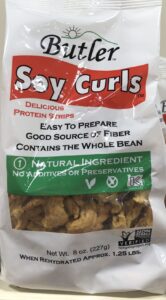 Soy curls are a lesser-known soy product. They are often used as a meat alternative because of their chewy texture and ability to absorb flavors of other ingredients they are combined with. We think they most resemble cooked chicken.
Soy curls are a lesser-known soy product. They are often used as a meat alternative because of their chewy texture and ability to absorb flavors of other ingredients they are combined with. We think they most resemble cooked chicken.
Soy curls are made by slowly cooking whole soybeans, and then stretching them into their unique shape. They are then dried, packaged and shipped. The most readily available variety is made by Butler Foods and can be ordered on Amazon, or you can pick it up in some grocery stores (Natural Grocer carries them in our area). One serving (3/4 cup dried) has 6 grams of fiber and 11 grams protein.
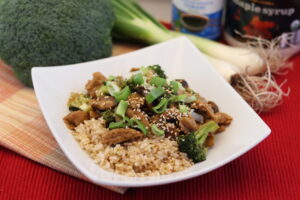 Enjoying them is as easy as rehydrating them in a bowl of hot water for about 10 minutes, and then draining them and add them to your recipe.
Enjoying them is as easy as rehydrating them in a bowl of hot water for about 10 minutes, and then draining them and add them to your recipe.
We recommend trying them in the Mongolian Soy Stir Fry! And, we think soy curls would be an excellent substitute for chicken or beef in the Chicken Teriyaki Bowl, Spicy Orange Chicken, Indian Chicken Biryani, Chicken Parmesan Pasta Bake, Sweet and Sour Chicken Stir Fry (using no egg and corn starch with the soy curls), Korean Beef and Veggie Bowl, Easy Chicken Bulgogi, Chicken Bulgogi Breakfast Burrito, Chicken Enchilada Bake, Cashew Chicken Bok Choy, and Asian Beef with Peppers. You can even substitute the tofu for soy curls in the Bacony Tofu Bites (see the quick tip on the recipe)!
Soy milk
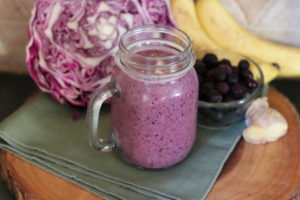 This dairy alternative can be made in a few different ways, often involving soaking soybeans in water, and then grinding, cooking and filtering the mixture to produce a slightly creamy, milk-like liquid.
This dairy alternative can be made in a few different ways, often involving soaking soybeans in water, and then grinding, cooking and filtering the mixture to produce a slightly creamy, milk-like liquid.
Many soy milks are also fortified with calcium and vitamins. If you are lactose intolerant, it can be an ideal option and can be enjoyed in a variety of recipes like smoothies, overnight oats, soups, sauces, and so much more. Soy milk is also used as an ingredient in foods like soy-based yogurts and cheeses. One cup of soy milk has about 7 grams of protein.
Like with all dairy products, it is important to read the ingredients, as many soy milks are flavored, which can include varying amounts of added sugars.
Soy milk would be fantastic in recipes like the Blueberry Overnight Oats, Easy Peasy Cheeseburger Macaroni, Red, White and Blueberry Popsicles, Purple Power Smoothie, Creamy Kale and Swiss Chard, Brownie Batter Dessert Hummus, and the Fruit-Topped Dutch Baby Pancake, just to name a few!
As you can see, there are several nutritious soy-based products out there that can be transformed into delicious meals!
We hope this provides some inspiration!
If you have other questions about soy, please ask us and we will try to help!
 LEARN MORE ABOUT THE NAPKIN!
LEARN MORE ABOUT THE NAPKIN!
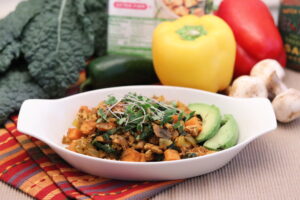
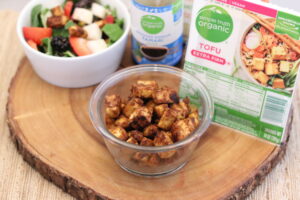
Very helpful. So many soy product recipe links & ideas at my fingertips. Thanks much Krista-going to try every single one… eventually.
Thank you and so happy these are helpful! I have no doubt you will try all of them, and we can’t wait to hear about it! 🙂